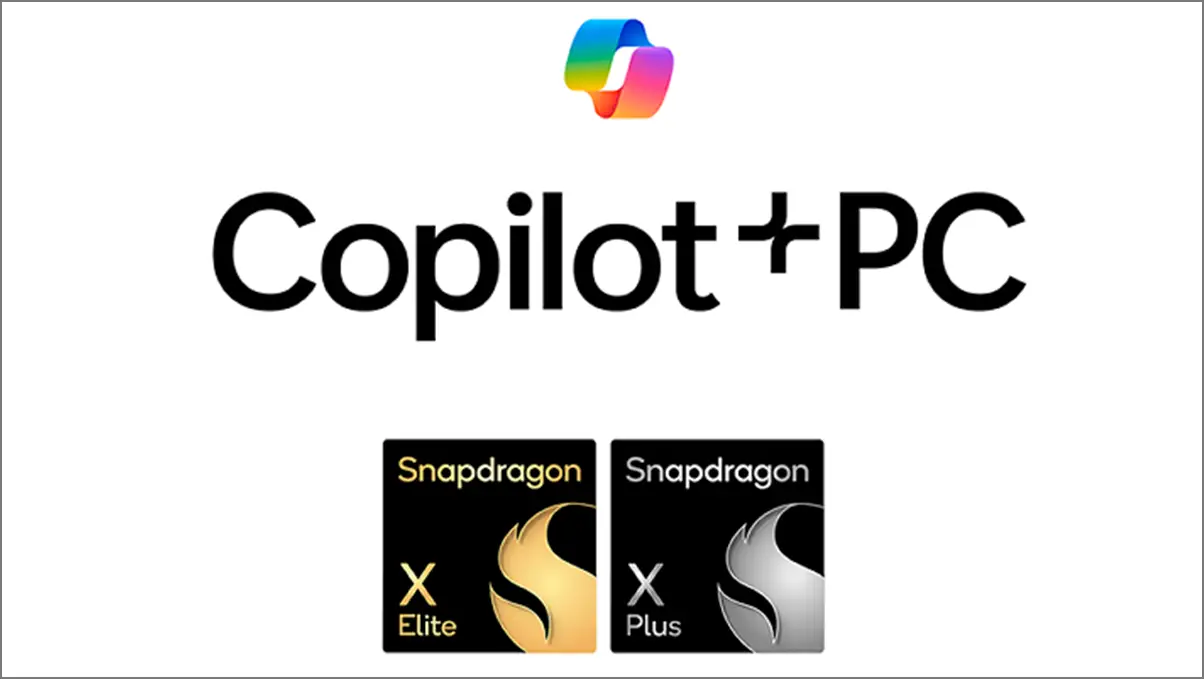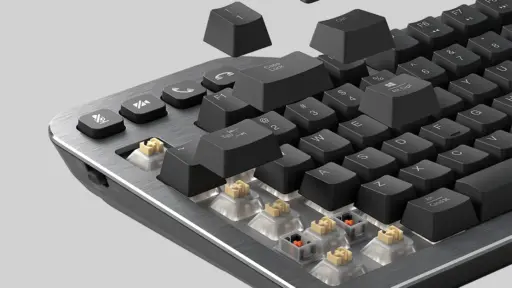We all know about Qualcomm’s Snapdragon processors for their performance, reliability, thermal cooling, and enhanced connectivity options on smartphone devices throughout the years.
Now, Qualcomm is ready to take on the laptop market with Microsoft by releasing the Snapdragon X series processors. The new chipset lineup offers better portability, increased battery life, power efficiency, 5G/LTE capabilities, and more.
So, you may ask: are Snapdragon-powered laptops worth the hype or not? Let’s find out.
A Quick Introduction to Snapdragon X Series Processors
Qualcomm has developed Snapdragon X series chipsets for ARM architecture-based laptops. After trying for 12 years, Microsoft has finally introduced Windows on the ARM platform. The company unveiled its powerful next-gen Copilot+ PCs with Snapdragon X series processors in April 2024. The Snapdragon X Elite and X Plus lineup SoCs will be used in compact & portable laptops.
Why Choose Windows on ARM Instead of x86 or x64 Architecture?
It took a decade or so to implement Windows on ARM because of the software compatibility issues. Overall, the emulation layer and performance dropdowns are pretty prominent in ARM. You’ll get improved performance, enhanced power efficiency, higher battery life in the segment, and more powerful AI processing on laptops.
Intel and AMD processors have achieved success by using the x86 architecture for decades. However, Qualcomm Snapdragon X series ARM chips are designed for extreme performance, stable connectivity, AI processing, and more. With the upcoming ARM optimizations and improved x86/x64 emulation layers, you’ll get refined compatibility with legacy Windows programs.
Features You Can Expect on a Snapdragon X Series Laptop
Microsoft and Qualcomm have officially collaborated with the Windows 11 Copilot+ laptops. The Snapdragon X Elite or X Plus series laptops come with the following hardware specs and features:
- CPU Specs: It features the ARM v9 architecture on the Snapdragon X Elite and X Plus series SoCs with Qualcomm’s custom Oryon CPU cores. The clock speed ranges from 3.2 GHz to 4.3 GHz, featuring an octa-core to 12-core and up to 42 MB cache memory. It can deliver up to 2x the speed of the x86 architecture.
- GPU: The integrated Adreno GPU supports graphics handling quite smoothly for gaming, media, streaming, and other productivity tasks.
- RAM: It features up to 64 GB LPDDR5x RAM (up to 8448 MHz) for faster data processing and memory management.
- NPU: Snapdragon X Elite and X Plus series SoCs offer a powerful hexagon NPU (Neural Processing Unit) that can handle 45 TOPS (Tera Operations Per Second).
- AI Processing Capabilities: Its designed for advanced AI computing tasks like Windows Recall, Live Caption, generative AI applications, real-time language translation, Cocreator, Windows Studio Effects, and more.
- Battery and Power Efficiency: Snapdragon series laptops offer exceptional battery life that can go all day long on casual or moderate usage. The ARM-based architecture of Snapdragon laptop processors is designed to consume low power even at high performance. So, you’ll get extended battery life while using these laptops or even in the standby mode compared to traditional laptops.
- Connectivity: The Snapdragon X series offers 5G connectivity with up to 10Gbps download speeds (sub-6GHz), Bluetooth 5.4, USB 4.0 ports, and Wi-Fi 7 capabilities. It’s optimized for high-speed and low-latency wireless connectivity.
Snapdragon X series laptops are optimized for longer battery life, power efficiency, and up to 4K display support for multi-monitor setups. Due to their sleek, fanless designs, you’ll get more compact laptops. Designed to work silently in quiet environments. More importantly, Snapdragon series laptops perform well in AI-related tasks efficiently.
However, it all comes down to the laptop manufacturer whether all of these features and hardware specs will be added to all of their Snapdragon-powered laptops or not.

List of Snapdragon X Elite and X Plus Processors
Snapdragon X series SoCs are capable of low power usage and workload shifts to the NPU instead of putting all the pressure on the CPU and GPU. Qualcomm claims that their Hexagon NPU is the ‘World’s fastest NPU for laptops’ because of its AI handling capabilities.
Before getting into the detailed info, you can take a quick look at the list of Snapdragon X Elite and X Plus series CPU variants below:
| CPU | Part Number | No. of Cores | CPU Max Multi-Core Frequency | CPU Boost Frequency | Adreno GPU TFLOPS | Hexagon NPU (TOPS) | Memory Type | Total Cache (MB) |
| Snapdragon X Elite | X1E-00-1DE | 12 | 3.8GHz | 4.3GHz (dual-core) | 4.6 | 45 | LPDDR5x-8448 | 42 |
| Snapdragon X Elite | X1E-84-100 | 12 | 3.8GHz | 4.2GHz (dual-core) | 4.6 | 45 | LPDDR5x-8448 | 42 |
| Snapdragon X Elite | X1E-80-100 | 12 | 3.4GHz | 4.0GHz (dual-core) | 3.8 | 45 | LPDDR5x-8448 | 42 |
| Snapdragon X Elite | X1E-78-100 | 12 | 3.4GHz | None | 3.8 | 45 | LPDDR5x-8448 | 42 |
| Snapdragon X Plus | X1P-66-100 | 10 | 3.4GHz | 4.0GHz (single-core) | 3.8 | 45 | LPDDR5x | 42 |
| Snapdragon X Plus | X1P-64-100 | 10 | 3.4GHz | 4.0GHz | 3.8 | 45 | LPDDR5x-8448 | 42 |
| Snapdragon X Plus 8 Core | X1P-46-100 | 8 | 3.2GHz | 4.0GHz (single-core) | 2.1 | 45 | LPDDR5x | 30 |
| Snapdragon X Plus 8 Core | X1P-42-100 | 8 | 3.2GHz | 3.4GHz (single-core) | 1.7 | 45 | LPDDR5x | 30 |
So you’re getting two entry-level Snapdragon X Plus CPU variants, two high-end Snapdragon X Plus CPU variants, and four premium-range Snapdragon X Elite series variants.
However, the actual performance of a laptop model and software-level optimization may vary depending on the manufacturer. Depending on the overall hardware specifications, laptop OEMs may charge higher prices for performance tweaks across CPU variants. Therefore, real-life performance metrics may also vary.
According to The Verge, the higher-end Snapdragon X Elite laptops are not performing well enough compared to Apple’s M3-powered laptops in head-to-head competition. The Snapdragon X series CPUs can compete well with Intel and AMD laptops.
Snapdragon X Series vs. Intel, AMD, and Apple Chips
ARM-based Windows laptops are new in the market right now compared to Intel and AMD chipsets. Windows on ARM deals with some caveats due to the overall inconsistency and platform instability. It also has some compatibility limitations with specific x86 applications to run correctly.
According to user reviews and critics, Snapdragon-powered laptops perform exceptionally well in some areas, like AI processing, increased battery life, sleek, lightweight design, and more. You’ll also get better multitasking power, reduced battery drain in standby mode, and enhanced wireless connectivity functions.
Snapdragon chips are more powerful in battery efficiency and AI processing tasks than certain x86 architecture-based Intel and AMD chips. Nevertheless, Snapdragon laptops fall behind in raw performance against the top-tier Intel and AMD chipsets.
- ARM Optimization Required: Windows on ARM lacks proper optimization and app development, resulting in major performance issues. Specifically, the transition layer or low-level coding may be holding up.
- Copilot+ Laptop Brands: Windows Copilot+ PCs on ARM are powered by Snapdragon X Elite and Snapdragon X Plus SoCs (System-on-Chip). Manufacturers like Dell, HP, Lenovo, ASUS, Acer, Samsung, and Microsoft offer such laptops.
- Comparison to Apple’s M-series Chips: Apple’s M2 Max and M3 Max chips perform much better in multi-core, though the Snapdragon X Elite chips showed a 2-3% jump in single-core. However, Snapdragon chips offer better battery efficiency and AI capabilities.
- Translation Layer: Apple’s translation layer ‘Rosetta’ runs Mac applications excellently. Mac apps were initially developed for previous-generation Intel-powered Macs. Sadly, Microsoft’s Prism emulator on Windows ARM still needs refinements to run x86 applications smoothly.
- Gaming Challenges: Although Snapdragon X series CPUs are powerful enough, the ARM limitation creates issues with high-performance gaming. So, Microsoft and Qualcomm need to think about gaming optimization.
- Future Possibilities: Microsoft has recently added Intel Core Ultra 200V and AMD Ryzen AI 300 series processors to bring more Copilot+ PCs to market. Meanwhile, Nvidia is also trying to get into the competition. So, it’s only a matter of time before we expect a better future with Windows ARM laptops ruling the segment.
What to Consider Before Choosing a Snapdragon Laptop
If you are considering buying a Snapdragon-powered laptop, you can check out the following things to know some potential downsides right now:
1. You May Get Variable Performance on Each Laptop
Snapdragon X Elite and X Plus lineups of processors are powerful enough for daily multitasking and AI-related tasks. These two are the segment’s best options and offer better thermal cooling performance. However, the entry-level X Plus octa-core series CPUs offer a lower TDP (thermal design power) level. That means slower clock speeds and a lower TDP will result in slower performance than the premium segment.
Laptop brands can easily tweak the performance capabilities of their Snapdragon X series laptop models depending on price and market trends. This means you may not always get the same level of performance when using the same specs on all laptop models.
2. Snapdragon Chips Perform Decently in Benchmarking
Snapdragon X Elite chips scored around 15,211 in multi-core performance and 2,880 in single-core performance via Geekbench. It indicates better multitasking and everyday tasks.
The Snapdragon X Plus chips gained a 28% multi-threaded performance jump using the power efficiency profile. The test was done against an Intel Core Ultra 7 and AMD Ryzen 9 7940HS.
3. Snapdragon Laptops Perform Better in Battery and AC Power Modes
As per The Verge, no significant performance differences were found between AC power and battery-powered test results. It was made on Snapdragon X series laptops with the same power profile.
- The Microsoft Surface Pro 11 underperformed by 7.5%-16% across all CPU tests using the ‘Recommended’ power management profile.
- However, the Dell XPS 13 performed well, around 0.9%-2.7%, and the Samsung Galaxy Book4 Edge performed around 1.3%-8.3% in the ‘Balanced’ power management profile.
Therefore, we can expect that Snapdragon-powered laptops can perform well even in battery mode using various power management settings. Choosing a higher performance profile will consume more battery and can reduce battery life.
4. Prism Emulator Requires Higher Optimization with x86/x64 Apps
Unfortunately, Snapdragon X series chips can’t perform similarly to the x86 chipsets in the competition. There is a lack of optimization on ARM64 emulation. You may get better benchmarking results for multitasking and AI processing but it underperforms in resource-heavy tasks. You can check out some key points below:
- Popular programs like Adobe Premiere Pro, Blender, Adobe After Effects, etc, lack hardware graphics acceleration for Windows on ARM.
- A few applications can run natively on ARM64, such as Adobe Photoshop, Mozilla Firefox, Microsoft Office, Google Chrome, Microsoft Edge, Zoom, and Microsoft To-Do. However, it falls short in crunch situations.
- Microsoft claims the Prism emulator is faster than Apple’s Rosetta 2 but fails in real-life usage while running heavy applications.
- Blender doesn’t detect the integrated Adreno GPU on Snapdragon laptops for 3D rendering and modeling tasks. This is happening on both native and x86 emulation versions. Though rendering times are faster than Intel Arc and AMD Radeon 780M GPUs, it’s way behind Apple M3 10-core GPU.
- Adobe Premiere Pro also requires Windows 11 ARM emulation optimization, as the program doesn’t run smoothly with heavy workloads.
5. Snapdragon’s Integrated Adreno Graphics are Underperforming
Snapdragon X series GPU doesn’t use its full potential to run native ARM64 apps with the Prism emulator, resulting in performance dips in graphics-heavy processes. Qualcomm’s Snapdragon X series CPUs are mainly designed for standard productivity and basic AI-related tasks. Thus, you can not expect resource-heavy tasks like 3D rendering until further optimizations are done.
On the bright side, the Snapdragon X Elite and X Plus series SoCs support up to a 1x 4K@120Hz display and up to 3x 4K@60Hz external displays. These SoCs don’t do well in comparison with AMD/Intel options, though.
Even the Intel Arc GPU performs up to 29% faster than the Snapdragon Adreno GPU and up to 39% better than other Snapdragon variants in Geekbench 6 benchmarking tests. The AMD Radeon 780M mobile integrated graphics also performs 17-29% better than the Snapdragon Adreno graphics in similar tests.
The Apple M3’s 10-core GPU underperforms by around 39% (slower) compared to the Snapdragon Adreno GPU in benchmarking. However, these results are too early to judge and may change over time.
6. Windows ARM Architecture is Not Designed for Gaming
Due to ARM limitations, we can’t expect high-end gaming on Snapdragon X series laptops. Even the Prism emulator lacks optimization levels to handle all mainstream video games on Windows ARM. However, a few popular PC games can run natively, sacrificing noticeable frame rate drops, force crashing, graphical glitches, etc.
Microsoft’s Automatic Super Resolution (auto-SR mode) is similar to Nvidia’s DLSS and AMD FSR, which use AI technology in real-time to improve gaming performance without reducing graphics quality. Sadly, SR mode is unable to achieve higher FPS while playing games. It barely touches 30FPS, even with a lower display resolution.
As a result, Snapdragon laptops heavily depend on the emulation process to run games. It includes popular games like Control, The Witcher 3, What Remains of Edith Finch, Palia, and Borderlands 3. Most Snapdragon X-powered Copilot+ PC users experience poor visual quality, screen flickering, FPS drops, and even startup crashes with video games. However, some games may run better by adjusting the graphics settings to low.
7. Power Efficiency in Snapdragon Laptops is Good Enough
The Snapdragon X Elite shines in the power efficiency part for handling light to moderate workloads. These devices will deliver the best results using the ‘Balanced’ and ‘Best Efficiency’ power profile settings.
Under maximum workload, power consumption can go up to 64 watts. Thus, it offers faster performance with higher power usage, which can lead to faster battery drain.
Each manufacturer can tweak the power consumption profiles on their Snapdragon laptops. Pricing depends on the specific model, technical specs, and pricing.
8. You’ll Get Improved Battery Life on a Single Charge
Microsoft claims that Copilot+ PCs with Snapdragon X series CPUs can deliver up to 20% increased battery life compared to its competitors. It offers excellent battery life depending on the power profile settings and usage pattern.
On an average day, you can get a good battery life on a single charge, unlike most Intel and AMD laptops. However, the higher brightness level and heavy multitasking can cause battery draining drastically.
For example, the Samsung Galaxy Book4 Edge can deliver nearly 14-16 hours of battery backup on a single charge. Though it’s not up to the mark, it’s good enough for a compact laptop.
On the other hand, Apple’s MacBook Air 15-inch can offer up to 18 hours of battery life on a single charge. This test was done with a brightness of 200 nits under a typical workload.
9. You Can Expect Variable Battery Life Across Snapdragon Laptops
The Verge used both the Microsoft Surface with Snapdragon X Plus and the Dell XPS 13 laptop with the Snapdragon X Elite CPU for the battery life test. Surprisingly, both laptops delivered around 12-14 hours of battery backup on a single charge, even with different processors.
It has a brightness level of 200 nits, and both laptops went through multiple performance tests, such as downloading Steam games and making video calls. However, it looks like lowering the brightness settings to 50% can increase battery life.
This indicates that some Copilot+ PCs may offer improved battery life compared to a few latest Intel and AMD laptops by a couple of hours overall. Here, software-level optimization plays a significant role.
10. Snapdragon Laptops Come at a Premium Price
Snapdragon-powered Copilot+ PCs are usually priced similarly to high-end Intel and AMD laptop models.
Snapdragon X series laptops are priced around $999 and can go up to $2,500. Pricing can vary depending on the laptop model and technical specifications.
These laptops may offer features like OLED displays, higher storage drives, a longer battery life, sleek & portable design, fanless operation, powerful CPU & GPU, enhanced connectivity options, etc.
We should also mention that even Intel and AMD laptops offer similar specs and features in this price range. So, it’s not as if you’re getting a Snapdragon X series laptop at a lower cost than the competition.
Pros and Cons of Snapdragon Laptops
From a customer’s point of view, Snapdragon-powered laptops may seem attractive. However, their value proposition will be based on the competitive price range and improved performance. So, the ARM compatibility issue and lack of optimized level can be a deal-breaker for Snapdragon laptops to buy right now.
To summarize, you can look at the pros and cons of Snapdragon laptops below:
Pros
- Optimized for sleek and fanless design laptops
- Excellent battery life
- Always-on LTE/5G connectivity
- Instant wake-up feature
- Integrated AI engine for advanced AI tasks
- Suitable for standard productivity and multitasking
Cons
- Software compatibility and unoptimized x86 emulation
- Not ideal for high-end gaming or heavy tasks
- Lower GPU performance
Should You Buy a Snapdragon X Series Laptop Right Now?
So, the ultimate buying decision depends on your budget and preferences. You can get Snapdragon laptops for standard multitasking, web browsing, better battery life, and improved power efficiency. These laptops have a sleek, fanless design, better thermal cooling, and enhanced wireless connectivity.
The Snapdragon X series laptops may not be suitable for resource-intensive tasks and high-end video gaming. In this case, consider x86-based Windows laptops. Although it is too early, it seems that Windows on ARM64 has a bright future in personal computing. We expect that Microsoft and Qualcomm will force Windows app developers to create native ARM64 versions at a larger scale.


